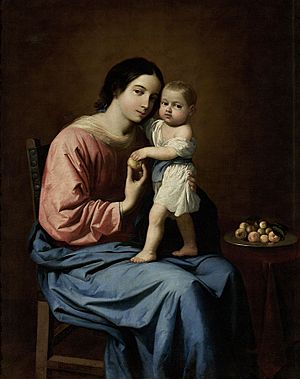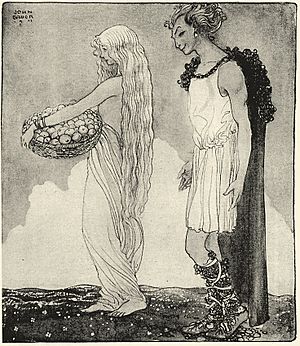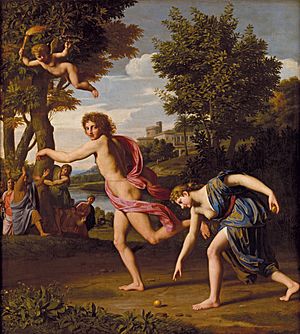Apple (symbolism) facts for kids

Apples show up in many religious stories and myths. They are often seen as a special or even forbidden fruit. It's tricky to know if these stories always mean the apple we eat today. This is because, until the 1600s, the word "apple" was used for almost any fruit that wasn't a berry. For example, when tomatoes first came to Europe, people called them "love apples." In some languages, potatoes are still called "earth-apples." Even oranges are sometimes called "golden apples" or "Chinese apples."
Contents
Apples in Myths and Religions
The Forbidden Fruit
Many people believe that Adam and Eve ate an apple from the forbidden tree in the Garden of Eden. The Bible doesn't actually name the fruit. But a popular Christian story says it was an apple. This idea might have come from the Greek myth of the golden apples in the Garden of Hesperides. Because of this, the apple became a symbol for knowledge, temptation, and making mistakes.
The word for apple in old Latin, mālum, sounded a lot like the Latin word for 'evil', mălum. This similarity might have helped the apple become known as the "forbidden fruit" in the Bible.
The part of your throat that sticks out, especially in boys, is called the Adam's apple. This name comes from the old story that a piece of the forbidden fruit got stuck in Adam's throat.

In art, if Adam holds an apple, it often means sin. But if Christ holds an apple, it means he brings new life and fixes the mistakes of mankind. This shows how the apple's meaning changed in Christian art. In the Old Testament, it meant falling into sin. In the New Testament, it means being saved from sin. You can also see apples in paintings of the Madonna and the baby Jesus. Here, the apple is a sign of being saved.
The Bible also uses apples in good ways. The phrase "the apple of your eye" means someone or something you value very much. In the Book of Proverbs, it says, "a word fitly spoken is like apples of gold in settings of silver." This means a well-said word is very precious. In the Song of Songs, apples are used to describe beauty.
During the Jewish New Year, called Rosh Hashanah, people often eat apples dipped in honey. This is a wish for a "new year that is good (like the apple) and sweet (like the honey)."
Greek Myths
In Greek myths, the Garden of the Hesperides was a special orchard. It had a tree that grew golden apples. These apples were a wedding gift from the goddess Gaia to Zeus and Hera. A dragon named Ladon guarded the garden.
In the story of the Judgement of Paris, Eris, the goddess of arguments, was not invited to a wedding. She got angry and threw a golden apple into the party. The apple was marked "For the most beautiful one." Three goddesses, Hera, Athena, and Aphrodite, all claimed it. Paris was chosen to decide who should get the apple. Aphrodite promised him the most beautiful woman in the world, Helen of Sparta. So, Paris gave the apple to Aphrodite. This choice eventually led to the famous Trojan War.
The Greek hero Heracles had to complete Twelve Labours. One of them was to go to the Garden of the Hesperides and pick the golden apples from the Tree of Life.
Another Greek myth tells of Atalanta, a fast runner. She raced all her suitors to avoid getting married. Hippomenes knew he couldn't beat her in a fair race. He used three golden apples, given to him by Aphrodite, to distract her. He threw the apples one by one, and Atalanta stopped to pick them up. This allowed Hippomenes to win the race and marry her.
Norse Myths
In Norse mythology, the goddess Iðunn keeps a special box of apples. The gods eat these apples when they start to get old. The apples make them young again. This happens until Ragnarök, the end of the world.
Once, a giant named Þjazi kidnapped Iðunn and her apples. Loki helped Þjazi trick Iðunn out of Ásgarðr, the home of the gods. Later, Loki rescued Iðunn by turning her into a nut. Þjazi chased them as an eagle. But when they reached Ásgarðr, the gods lit a bonfire that burned Þjazi.

Apples are also linked to fertility (making new life) in Norse myths. In one story, a god named Freyr sends his messenger to woo a beautiful woman named Gerðr. The messenger offers her eleven golden apples. In another tale, the goddess Frigg sends an apple to King Rerir after he prays for a child. A crow drops the apple into his lap, and he later has a son.
Celtic Myths
Apples and apple trees are very important in Celtic mythology and folklore. They often represent fruitfulness and sometimes even a way to live forever. Druids, who were Celtic priests, sometimes made their special wands from apple wood.
Allantide is a traditional festival from Cornwall, England. It's celebrated on October 31st and the next day. A key part of this festival was giving "Allan apples" to family and friends for good luck. These were large, shiny red apples. People also played a game where they tried to catch apples hanging from a cross-shaped frame with their mouths. Unmarried people would put Allan apples under their pillows. They hoped to dream about their future husband or wife.
In the Irish tale The Voyage of Bran, the hero Bran finds a silver apple branch with white blossoms. This magical branch leads him on a journey to the Celtic Otherworld, a magical land.
Another magical silver branch with three golden apples belonged to the sea god Manannán mac Lir. This branch made soothing music that helped people who were hurt or sick fall asleep. In the tale Echtra Condla, a fairy gives a young man an apple. This apple keeps him fed for a month without getting smaller. But it also makes him want to go to the fairy's beautiful land.
In the Arthurian legends, the island of Avalon is known as the Isle of Apples. Its name comes from a Welsh word for apple. The island is described as having many apple trees. Avalon was also believed to be the home of the magical Morgan le Fay and her sisters.
Legends, Folklore, and Traditions
- In some parts of the world, people celebrate "Apple Day" on October 21st. This festival supports local traditions, old songs, and protecting different kinds of apple trees.
- In Irish and Finnish folklore, if you peel an apple in one long ribbon and throw it over your shoulder, it's said to land in the shape of your future husband's or wife's first initial.
- A fun folk art involves shaping apples into wrinkly faces, often used for dolls.
- Apple bobbing is a popular game played during Halloween.
- In the United States, Denmark, Finland, and Sweden, giving a fresh, shiny apple to a teacher was a common gift in the 1800s. Even today, apples are a strong symbol for teachers.
- The Apple Wassail is a old tradition in South West England. People visit cider orchards in winter to "bless" the apple trees. They hope this will help the trees grow a good crop of apples next season.
- The saying "comparing apples and oranges" means trying to compare two things that are completely different.
- "An apple a day keeps the doctor away" is a famous saying. It means that eating healthy foods, like apples, helps you stay well.
- Johnny Appleseed was a real person who traveled across the early United States. He planted apple trees everywhere he went.
- The city of Almaty in Kazakhstan gets its name from the Kazakh word for 'apple'. So, Almaty means "full of apples."
Images for kids
-
The Virgin and Child Under an Apple Tree, Lucas Cranach the elder
-
Two Young Men,
Crispin van den Broeck (Dutch), ca. 1590; Oil on panel; Fitzwilliam Museum, Cambridge.





